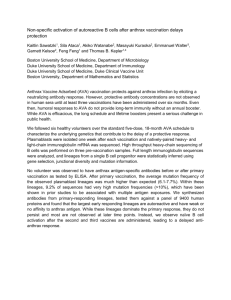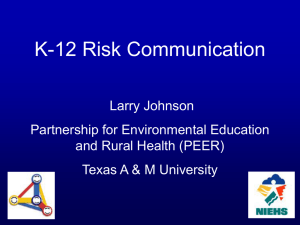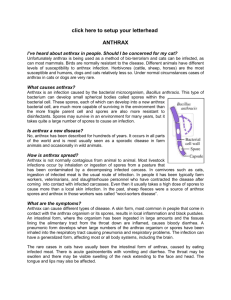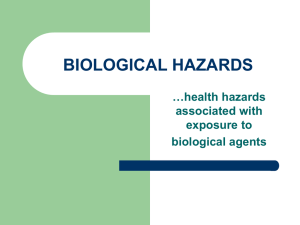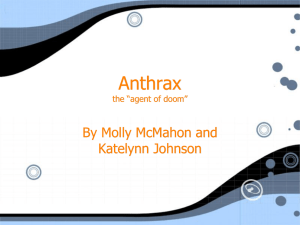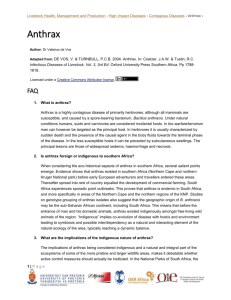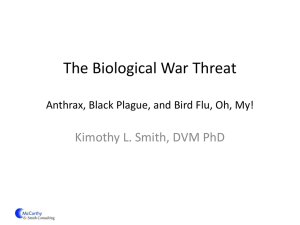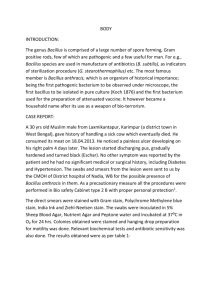anthrax_5_control
advertisement
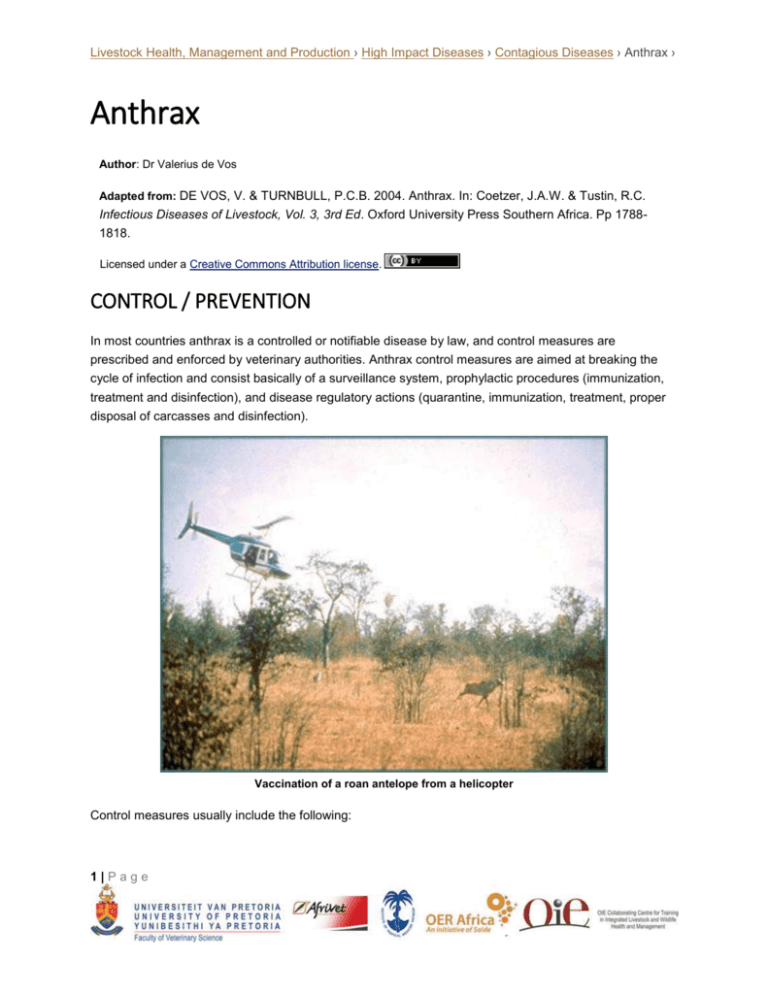
Livestock Health, Management and Production › High Impact Diseases › Contagious Diseases › Anthrax › Anthrax Author: Dr Valerius de Vos Adapted from: DE VOS, V. & TURNBULL, P.C.B. 2004. Anthrax. In: Coetzer, J.A.W. & Tustin, R.C. Infectious Diseases of Livestock, Vol. 3, 3rd Ed. Oxford University Press Southern Africa. Pp 17881818. Licensed under a Creative Commons Attribution license. CONTROL / PREVENTION In most countries anthrax is a controlled or notifiable disease by law, and control measures are prescribed and enforced by veterinary authorities. Anthrax control measures are aimed at breaking the cycle of infection and consist basically of a surveillance system, prophylactic procedures (immunization, treatment and disinfection), and disease regulatory actions (quarantine, immunization, treatment, proper disposal of carcasses and disinfection). Vaccination of a roan antelope from a helicopter Control measures usually include the following: 1|Page Livestock Health, Management and Production › High Impact Diseases › Contagious Diseases › Anthrax › Effective surveillance and reporting procedures, providing an early warning system, and delineating high-risk areas. Quarantine procedures, isolating an infected and contaminated area and animals until safe. Preventing excess sporulation of the vegetative growth form of B. anthracis by not opening carcasses. For disposal of carcasses, burial should be discouraged in favour of incineration. Where burial is done, carcasses should be buried at a depth of two metres after being covered liberally with a mixture of chloride of lime, containing at least 25 per cent of active chlorine, and enclosed in plastic sheeting; the rationale being that chlorine gas develops and sterilizes the carcass. The WHO has published guidelines for the disinfection of B. anthracis-infected material. For disinfection or decontamination of anthrax-infected/contaminated material and soil, formaldehyde (2%-10%) is generally preferred. In particularly valuable animals exposed to anthrax, treatment with bactericidal antibiotics may be used as a prophylactic measure. Simultaneous vaccination is contraindicated. Vaccination with Sterne spore vaccine. Annual vaccination is recommended for all cattle in highrisk areas. During an outbreak vaccination of all cattle in the immediate surroundings and incontact herbivores is recommended. This also applies to captive wild animals where possible. The Sterne vaccine is for all practical purposes non-pathogenic in most domestic and wild animal species. It however, appears to retain a degree of virulence for certain species such as goats and llamas. In such species, two inoculations one month apart, with the first being one quarter of the standard dose and the second being the full standard dose, are recommended. In horses, being slow to react, two standard doses one month apart and a single annual booster thereafter are recommended. In the other species a single inoculation provides effective immunity for about nine months to a year. Effective immunity generally develops within a week of vaccination, although in horses it may take a month or more. Outbreaks of anthrax in livestock are usually brought under control within a week to ten days of vaccination of affected herds. While control of anthrax has become a distinct possibility in livestock areas, anthrax in freeranging wildlife in several regions of the world retains a continued place in the ecology of African wildlife. In the southern African large wildlife parks, anthrax is now accepted as indigenous and one of a spectrum of natural culling mechanisms. However, at the interface with local populations and their livestock it can present risks and thus the need for control. While anthrax can be controlled and even eradicated in livestock, control in wildlife is largely impractical and almost impossible. Nevertheless, herd animals such as Burchell's zebra (Equus burchelli burchelli), blue wildebeest (Connochaetes taurinus), African buffalo (Syncerus caffer) and American bison (Bison bison) that can be corralled or captured, can be vaccinated. Long-stemmed, hand-held automatic vaccinating syringes and dart syringes are used from the sides of the boma or crush. An aerial 2|Page Livestock Health, Management and Production › High Impact Diseases › Contagious Diseases › Anthrax › method of immunizing free-ranging wildlife was also developed for especially small populations of endangered species. In the major game reserves most of the control measures, as used for livestock, are difficult, if not impossible, to apply and/or enforce. In addition, anthrax being considered indigenous and a natural and integral part of the ecosystems of some of these areas, makes it debatable whether active control measures should actually be instituted. In the National Parks of South Africa, the current policy is to institute active control measures against anthrax only if it affects biodiversity negatively (e.g. by threatening the survival of low density or threatened species), and/or where the actions of humans (such as fencing or the provision of artificial watering points), are providing unnatural impetus to an outbreak. A general rule of thumb for deciding whether or not to implement control measures in wildlife areas is that the bigger and more natural and selfsufficient an area is, the less control measures should be implemented, and vice versa. Apart from immunization, anthrax control procedures which have been used in wildlife situations are inter alia: the fencing-off of known anthrax-contaminated water or burning of vegetation; the location and covering, incineration or burial (as specified above) of carcasses as soon as possible to prevent their dismemberment by scavengers (a helicopter or fixed-wing aircraft was found to be virtually essential in locating carcasses in an extensive area); and the replacement of natural waterholes by concrete drinking troughs in which the water (contaminated by scavengers) can be disinfected. 3|Page

